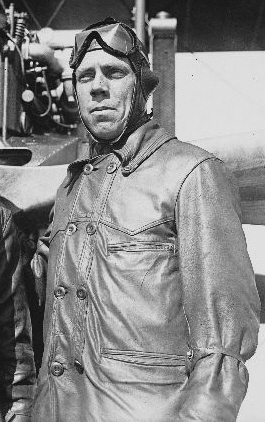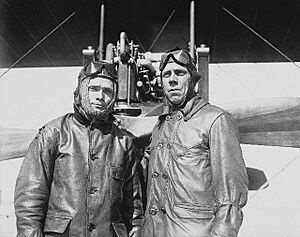James Floyd Smith facts for kids
Quick facts for kids
James Floyd Smith
|
|
|---|---|

Smith circa 1915 in San Diego
|
|
| Born | October 17, 1884 |
| Died | April 18, 1956 (aged 71) |
| Resting place | Portal of Folded Wings |
| Education | Public schools in Union, Oregon and San Diego, California |
| Occupation | Engineer Instructor Pilot Test Pilot Parachute Manufacturer |
| Employer | Glenn Martin Smith Parachute Company |
| Known for | Aviation pioneer Parachute |
| Spouse(s) | Hilder F. Youngberg(1890-1977) |
| Children | 2 |
| Awards | Medal of Merit from the Aero Club of America |
James Floyd Smith (born October 17, 1884 – died April 18, 1956) was an amazing inventor and a pioneer in aviation. He is best known for creating the first modern parachute. He even built his own airplane and taught himself how to fly it!
Floyd Smith worked as a flight instructor and test pilot for Glenn L. Martin. This was at a place that later became LAX. In 1916, he set three altitude records in a seaplane, flying as high as 12,333 feet! During World War I, he started his own company, the Floyd Smith Aerial Equipment Company. In 1920, he received a patent for the first backpack parachute that used a ripcord for free-fall. You can see his original ripcord parachute at the National Museum of the United States Air Force in Ohio.
Contents
Who Was James Floyd Smith?
Smith was born in Geneseo, Illinois. His family later moved to Union, Oregon. Before becoming an aviation pioneer, Floyd had many interesting jobs. He was a cowboy, a machinist, and even a trapeze artist with a flying circus called the Flying Sylvesters!
Family Life
In 1907, he married Hilder Florentina Youngberg, who was also a daredevil performer in the Flying Sylvesters. They had two sons, Sylvester and Prevost. Sadly, Sylvester passed away at a young age in 1919.
Building His Own Plane
With help from Hilder and a friend named Frank Shaw, Floyd built his own airplane. He flew it for the first time on June 1, 1912. This showed his incredible skill and determination.
Working with Aviation Companies
In 1915, Floyd Smith started working for the Glenn L. Martin Company as a mechanic and test pilot. Later, he founded his own company, the Floyd Smith Aerial Equipment Company. He was also asked to join a special US Army team that designed parachutes.
He worked with the Switlik Parachute Company in the 1920s. There, he designed a new ripcord and parachute pack that worked better and cost less. He also invented the "Floyd Smith Safety Seat." This was a special seat with a parachute attached that could drop out of an airplane in an emergency.
Pioneer Parachute Company
In 1938, Smith helped start the Pioneer Parachute Company. He became its vice president and chief engineer. During World War II, nylon replaced silk for parachutes because silk was hard to get. Pioneer became the biggest producer of nylon parachutes in the world by 1942. At its busiest, 3,000 employees made 300 parachutes every day! Pioneer supplied many parachutes for American soldiers, including those who jumped on D-Day.
Smith Parachute Company
After working at Pioneer, Floyd and his son Prevost started the Smith Parachute Company in San Diego in 1947. After Floyd passed away in 1956, his son continued the company, renaming it Prevost F. Smith Parachute Company. They kept inventing new parachute designs for astronauts, military uses, and large defense companies.
Later Life and Legacy
Floyd Smith died on April 18, 1956, in San Diego, California. He is buried at the Portal of Folded Wings Shrine to Aviation. In 2009, he received a special award for his achievements in the parachute industry.
Inventing the Modern Parachute
In 1914, Floyd Smith's wife had a scary experience with a parachute that almost went wrong. This made him determined to make parachutes safer and better.
The First Free-Fall Parachute
He filed a patent for his new parachute design on July 27, 1918. It was officially approved on May 18, 1920. This design was very important because it was the first backpack parachute that allowed a person to free-fall and then pull a ripcord to open the chute.
In 1918, General Billy Mitchell asked a team to find the best parachute design. Floyd Smith was chosen for this team. His team developed the "Type A" parachute. It had a soft pack worn on the back, a ripcord to open it, and a small pilot chute to help the main parachute open.
Testing the New Parachute
Some people worried that a free-fall parachute was too dangerous. They thought a jumper might pass out before pulling the ripcord. But Floyd Smith and another aerial performer, Leslie Irvin, convinced them to test it.
On April 28, 1919, Leslie Irvin volunteered to jump with the "Type A" parachute. Floyd Smith piloted the airplane. Irvin jumped from 1500 feet and pulled the ripcord at 1000 feet. He became the first American to jump from a plane and manually open a parachute in midair! This successful test proved that the free-fall parachute was safe.
Impact on Aviation Safety
After many successful tests, the US Army decided that all Air Service flights must use parachutes. This made flying much safer for pilots.
The Irving Air Chute Company later started the Caterpillar Club. This club gave a gold pin to pilots who successfully used an Irving parachute to escape a disabled aircraft. Other companies, like Switlik Parachute Company, also gave out similar pins.
Floyd Smith's original 1919 ripcord parachute is on display at the Air Force Museum in Dayton, Ohio. He received a total of 33 patents for his many inventions!
| Floyd Smith Aerial Life Pack | Pat. No. 1,340,423 | Filed: 27 July 1918 | Issued: 18 May 1920 | Title: Parachute | Floyd Smith Aerial Equipment Co., San Diego, California |
| “Type A” | Pat. No. 1,462,456 | Filed: 28 April 1919 | Issued: 17 July 1923 | Title: Parachute Pack and Harness | Floyd Smith Aerial Equipment Co, later US Govt paid transfer to Irving Air Chute Company |


